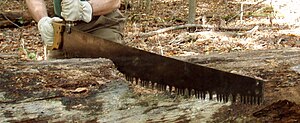Features and Types of Crosscut Saws
– Crosscut saws can have a wooden handle with a right-angled return edge, allowing them to be used as a square for marking materials.
– Larger saws used for forestry and logging work include one-man and two-man saws, as well as bucking and felling saws.
– Bucking saws have a straighter back and are used on downed trees, while felling saws have a curved back and are used to cut down standing trees.
– Crosscut saws used in carpentry are smaller hand saws.
– Some crosscut saws are designed to cut only on the pull stroke, while others are designed to cut on the push stroke.
How Crosscut Saws Cut
– Crosscut saws have cutting teeth, rakers, and gullets.
– As the saw is pulled toward the operator, the cutters score the wood on both sides of the blade, cutting a channel downward.
– The raker follows the cutters, paring the bottom of the kerf like a chisel or plane.
– Wood accumulates in the gullets and is allowed to fall out when the saw is drawn out of the kerf.
– The crosscut saw tooth has a knife-like cutting action, reducing bending within the work-piece.
Crosscut Saws versus Chainsaws
– Felling or bucking is a dangerous job, and both chainsaw and crosscut saws have their own risks.
– A kit for crosscut saw work weighs less than a chainsaw kit, which includes fuel, oil, tools, and personal protective equipment.
– Crosscut saws require sharpening by a skilled filer, while chainsaws require engine tuning, chain tensioning, and chain maintenance.
– Crosscut saws require more space to operate and allow the sawyer to stand farther away from the log, increasing safety.
– Crosscut saw usage is permitted on all federal lands in the United States, while chainsaw usage is restricted in designated wilderness areas.
History of Crosscut Saws
– Crosscut saws have been in use since historic times, with changes in design to accommodate different trees, metallurgy technology, and experience.
– Records exist of crosscut saws being used during the Roman Empire.
– Crosscut saws became widely used in Europe in the 15th century, with the development of the M tooth pattern in south Germany.
– Prior to 1880, crosscut saws were mainly used for bucking, with axes used for felling trees.
– Despite the modern chainsaw, crosscut saws are still widely used around the world due to their advantages.
Vintage Saws versus Modern Saws
– Vintage saws can be 30 to 250 years old and are sought after by professionals, making them more expensive than modern crosscut saws.
– Modern saws are typically made from sheet metal and contemporary alloys, behaving differently from vintage saws.
– Vintage saws are highly valued for their historical significance and craftsmanship.
– Modern crosscut saws are more readily available and affordable.
– Both vintage and modern crosscut saws have their own advantages and appeal to different users. Source: https://en.wikipedia.org/wiki/Crosscut_saw
This article has multiple issues. Please help improve it or discuss these issues on the talk page. (Learn how and when to remove these template messages)
|
A crosscut saw (thwart saw) is any saw designed for cutting wood perpendicular to (across) the wood grain. Crosscut saws may be small or large, with small teeth close together for fine work like woodworking or large for coarse work like log bucking, and can be a hand tool or power tool.


The cutting edge of each tooth is angled in an alternating pattern. This design allows each tooth to act like a knife edge and slice through the wood in contrast to a rip saw, which tears along the grain, acting like a miniature chisel. Some crosscut saws use special teeth called rakers designed to clean out the cut strips of wood from the kerf. Crosscut saws generally have smaller teeth than rip saws.
Some saws, such as Japanese saws and those used by the ancient Egyptians, are designed to cut only on the pull stroke. Western saws, on the other hand, are designed to cut on the push stroke.[citation needed] Cross cut saws designed for log bucking and tree felling are designed to cut on the pull stroke
